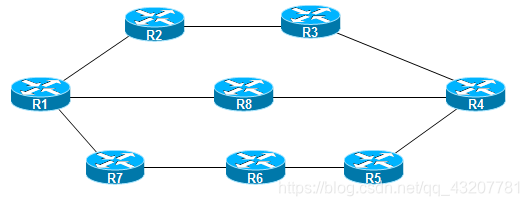(2)CBR 的讲解(是 OSPF / ISIS 对 TE 的扩展,确定 tunnel 的建立路径)
1)普通的链路状态协议选路依据的参数(SPF)
三元组:Router-ID,Neighbor-ID,Cost
2)CBR 为支持 MPLS TE 对普通链路状态协议的改进(CSPF)
相对于三元组添加的其他参数(六元祖,九元祖)
OSPF的新增的LSA 10
关于OSPF的扩展说明(也叫Opeque LSAs):
LSA9:Link-local scope(只在链路间泛洪,用于OSPF NSF多)
LSA10:Area-local scope(只在本区域内泛洪)
LSA11:AS-wide scope(在整个OSPF域内泛洪)
3)ISIS 的 3 个新增的 TLV(TLV 22 / TLV 134 / TLV 135)
关于 ISIS 的扩展说明:
TLV 22:扩展的中间系统可达性 TLV(CLNS扩展)
TLV 134:流量工程 RouterID TLV
TLV 135:扩展的 IP 可达性 TLV(IP 的扩展)
Cisco 将 MPLS TE 称为资源保留路由协议
(Routing with Resource Reservation,RRR)

r1(config)#router isis
r1(config-router)#metric-style wide(一定要使用该命令,要不然不能携带TE信息)
CBR 在什么情况下会泛洪 TE 的信息?
1、对预留带宽的变化(预留带宽消耗得越多,泛洪间隔越快)
r2(config-subif)#mpls traffic-eng flooding thresholds up/down xx(up表示可用资源越来越多,释放得越多)
r2#show mpls traffic-eng link-management bandwidth-allocation xx
R1(config-subif)#mpls traffic-eng flooding thresholds ?
down Set the thresholds for decreased resource availability
up Set the thresholds for increased resource availability
R1(config-subif)#mpls traffic-eng flooding thresholds up 10 30 40 50 60 (IOS会自动纠正顺序)
2、配置变化:如修改 tunnel 中的带宽要求
3、在隧道设置失效之后
4、RSVP预留带宽的改变
5、周期性泛洪,比IGP更快(默认OSPF 30 min / ISIS 15 min),TE信息的泛洪周期默认是3 min
r2(config)#mpls traffic-eng link-management timers periodic-flooding xxx